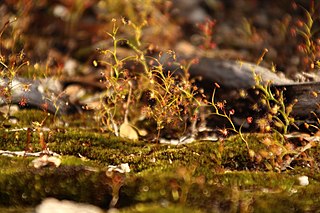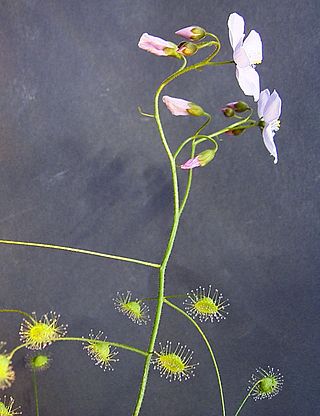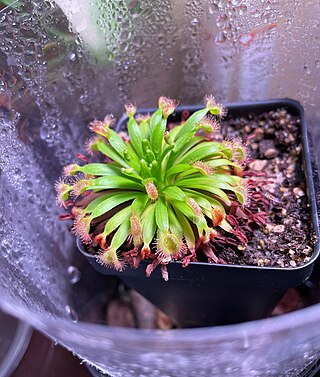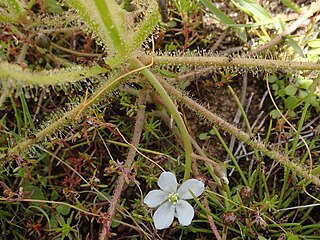Allen Lowrie was a Western Australian botanist. He was recognised for his expertise on the genera Drosera and Stylidium.

Drosera monticola is a perennial carnivorous plant species in the genus Drosera, the sundews. This species is endemic to a single mountain range in Western Australia.

Drosera stolonifera, sometimes referred to as the leafy sundew, is a tuberous perennial species in the genus Drosera that is endemic to Western Australia. It produces 2 to 3 semi-erect lateral stems that grow 10 to 15 cm long. It is most closely related to D. purpurascens, but differs by several characteristics including height and petiole length. It is native to a number of swampy locations around Perth south to Pinjarra. It grows in peaty water-logged soils in swamp heathland and flowers from September to October. After a bushfire it will flower en masse.

Drosera sect. Stolonifera is a section of ten tuberous perennial species in the genus Drosera that are endemic to south-west Western Australia. The species all have a similar growth habit and all have fan-shaped leaves, but the morphological differences and lack of natural hybrids support the division of the D. stolonifera species complex.

Drosera erythrorhiza, the red ink sundew, is a perennial tuberous species in the carnivorous plant genus Drosera that is endemic to Western Australia. It grows in a rosette and is distinguished from the other species in section Erythrorhiza by its many-flowered cymose inflorescences with up to 50 individual flowers. D. erythrorhiza was first described by John Lindley in his 1839 publication A sketch of the vegetation of the Swan River Colony. In 1992, N. G. Marchant and Allen Lowrie described three new subspecies, thus also creating the autonym D. erythrorhiza subsp. erythrorhiza. The subspecies were separated from this variable species mostly by leaf morphology and distribution.

Drosera bicolor is an erect perennial tuberous species in the genus Drosera that is endemic to Western Australia. It produces a basal rosette of leaves similar to that of D. peltata and the stem grows to 11 cm (4 in) high. Its white flowers that have a red spot near the petal base emerge from September to October. D. bicolor grows in deep silica sand on heathland along the upper Phillips River and south-east of Lake King.

Drosera erythrogyne is a scrambling or climbing perennial tuberous species in the genus Drosera that is endemic to Western Australia. It grows in soils that are peat-sand to loam and occurs in an area along the southern Western Australian coast west of Albany in swamps or near granite outcrops. It produces small leaves along a long, scrambling stem that can grow to 2–3 m (7–10 ft) long. White flowers emerge from August to October.

Drosera gigantea, the giant sundew, is an erect perennial tuberous species in the carnivorous plant genus Drosera that is endemic to Western Australia. It grows in sandy soils at the margins of swamps and near granite outcrops along the Western Australian coast from Albany north to just south of Geraldton. D. gigantea produces small shield-shaped leaves along many lateral branches that look like a small tree. Individual plants can grow up to 0.2–1 m (0.7–3.3 ft) tall. Because of its tall, tree-like form, it is considered one of the largest Drosera species. It is also easily cultivated and enjoys damp, humid conditions often provided in greenhouses. White flowers emerge from August to November. The red tubers of this species can grow to be 3.8 cm (1.5 in) in diameter and may be a metre below ground.

Drosera macrantha, the bridal rainbow, is a scrambling or climbing perennial tuberous species in the carnivorous plant genus Drosera that is endemic to Western Australia. It grows in a variety of habitats, including winter-wet depressions in sandy, loamy, laterite, or quartzite soils. D. macrantha produces small, cup-shaped carnivorous leaves along a long stem that can be 0.16–1.5 m (0.5–4.9 ft) high as it climbs. Its 1 in (2.5 cm) white or pink flowers emerge from June to November, blooming earlier in the more northern range.
Drosera marchantii is an erect perennial tuberous species in the carnivorous plant genus Drosera. It is endemic to Western Australia and grows in a variety of habitats, including swampy areas and hilltops in laterite-silica sand soils. D. marchantii produces small, circular, peltate carnivorous leaves along stiff stems that can be 10–40 cm (4–16 in) high. Its pink flowers emerge from June to October.

Drosera menziesii, the pink rainbow, is an erect or scrambling perennial tuberous species in the carnivorous plant genus Drosera. It is endemic to Western Australia and grows in a variety of habitats, including winter-wet depressions, swamps, and granite outcrops in clay or peat sand soils or loam. D. menziesii produces small, circular carnivorous leaves along an undulating erect stem that can be .05–1.1 m (0.2–3.6 ft) high. Its pink flowers emerge from July to November.
Drosera moorei is a scrambling or climbing perennial tuberous species in the carnivorous plant genus Drosera. It is endemic to Western Australia and grows near granite outcrops in sandy loam. D. moorei produces small, circular, peltate carnivorous leaves along glabrous stems that can be 12–35 cm (5–14 in) long. Inflorescences have two to ten yellow flowers and bloom from September to October.
Drosera salina is an erect perennial tuberous species in the carnivorous plant genus Drosera. It is endemic to Western Australia and is only found in salt-free sand on the margins of salt lakes in a few locations north of Albany east to north-west of Esperance. The specific epithet, salina, refers to the salt lake margins that this species inhabits. D. salina produces small carnivorous leaves along stems that can be 7 cm (3 in) high. White flowers bloom from July to September.

Drosera stricticaulis, the erect sundew, is an erect perennial tuberous species in the carnivorous plant genus Drosera. It is endemic to Western Australia and is found near watercourses and granite outcrops in sandy clay or loam. D. stricticaulis produces small, cup-shaped carnivorous leaves along green, glandular stems that can be 25 cm (10 in) high. Pink flowers bloom from July to October.
Drosera subhirtella, the sunny rainbow, is a scrambling or climbing perennial tuberous species in the carnivorous plant genus Drosera. It is endemic to Western Australia and is found in sandplains, granite outcrops, and swamp margins in sand, clay, and loam soils. D. subhirtella produces small carnivorous leaves along stems that can be 40 cm (16 in) high. Yellow flowers bloom from August to October.
Drosera subtilis is an erect annual species in the carnivorous plant genus Drosera. It is native to northern Western Australia and a single site in the Northern Territory. In Western Australia, it has been collected from Beverley Springs Station, Bigge Island, and the Mitchell Plateau area all in the vicinity of the Kimberley region. In the Northern Territory, it has been found near Little Nourlangie Rock. It grows over sandstone near seepage margins in skeletal sandstone sand and black humus mixed soils. D. subtilis is anchored to the soil by a system of thin, fleshy roots and it lacks a tuber. It produces small carnivorous leaves along erect, reddish stems that can be 20 cm (8 in) high.
Drosera sulphurea, the sulphur-flowered sundew, is a scrambling perennial tuberous species in the carnivorous plant genus Drosera. It is endemic to Western Australia and is found in coastal areas in sandy loam, often among Cephalotus. D. sulphurea produces small, shield-shaped carnivorous leaves along stems that can be 40–60 cm (16–24 in) high. Yellow flowers bloom in September.

Drosera fulva is a carnivorous plant in the genus Drosera and is endemic to the Northern Territory in Australia. Its semi-erect or prostrate leaves are arranged in a compact basal rosette. Oblanceolate petioles emerging from the center of the rosette are typically 2–3 mm wide at its widest. Red carnivorous leaves at the end of the petioles are small and round at 2–3 mm in diameter. Inflorescences are 25–45 cm (10–18 in) long with white or sometimes pink flowers being produced on 50-or-more-flowered racemes from February to May.

Drosera finlaysoniana is a carnivorous herb found in Australia and south east Asia. More commonly found in the north of Australia. In southern Australian sites it has been recorded at inland areas, in eucalyptus woodlands subject to flooding. Also found in Hainan, Taiwan, the Indo-China region and the Philippines.
Drosera nivea is a species of carnivorous plant. It is a pygmy sundew and is native to Western Australia. The specific epithet nivea is derived from the Latin word niveus, meaning white, in reference to the colour of the plant's flower. It is closely related to Drosera citrina and has previously been considered a variety of D.citrina known as D. citrina var. nivea.












